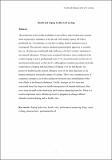Health and doping in elite level cycling.

Type de référence
Date
2012Langue de la référence
AnglaisEntité(s) de recherche
Résumé
The protection of the health of athletes is one of the threecriteria taken into account when registering a substance inthe World Anti-Doping Agency prohibited list. Neverthe-less, in elite-level cycling, banned substance use is wide-spread. The present research adopted a psychologicalapproach to examine how or whether perceived health risksinfluence elite-level cyclists’ decisions to use banned sub-stances. Sixteen semi-structured interviews were conductedwith cyclists hoping to join a professional team (n 5 6), neo-professional cyclists (n 5 2), and former professional cy-clists (n 5 8). Although an evolution was observed in theorganization of doping and perceptions of doping over thelast decade, the perceived health hazards did not influence,most of the time, decisions to use banned substances amongthe sample of cyclists. There was a systematization ofexogenous substance use in the cycling environment and atrivialization of the side effects of the banned substances.Finally, younger cyclists were not concerned about the long-term health consequences of banned substances; they weremore focused on the short-term performance-enhancingbenefits. There is a need to implement more effectivepreventive programs to change athletes’ attitudes towarddoping and its health risks.Titre du périodique
Scandinavian Journal of Medicine and Science in SportsMaison d’édition
Wiley-Blackwell Publ.Pays d'édition
Grande-Bretagnep-ISSN
0905-7188e-ISSN
1600-0838Volume / tome
22Fascicule
5Pagination
596-606URL permanente ORFEE
http://hdl.handle.net/20.500.12162/156Autre(s) URL(s) permanente(s)
http://doi.org/10.1111/j.1600-0838.2010.01281.xDocument(s) associé(s) à la référence
Texte intégral :
Fichier
Accès
Commentaire
Version
Taille
Lentillon-Kaestner_et_al-2012-Scandinavian_Journal_of_Medicine_Science_in_Sports_PostprintAuthor.pdf
Ouvert
postprint auteur
202.7ko
Sur demande
postprint éditeur
147.1ko
- Tout ORFEE
- Détail référence



